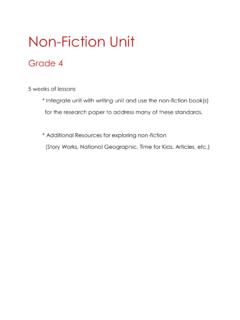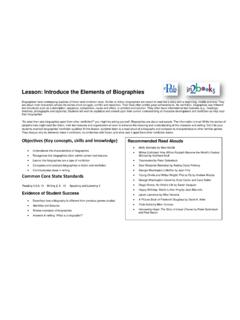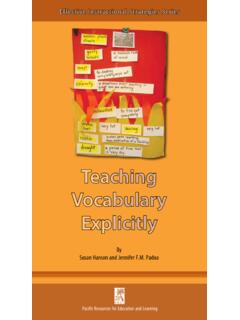Transcription of Strategies for Teaching Text Structure
1 20 Strategies to Teach Text Structure Shared by: Kristi Orcutt, Reading & Writing Consultant, As early as third grade, students are expected to recognize expository text structures such as the following: sequence, description, compare-contrast, cause-effect, and problem -solution. The ability to identify and analyze these text structures in reading helps make expository text easier to understand. Students should also use these text structures to organize their own writing. The following research-based Teaching Strategies can be applied in Teaching students to use text Structure : 1. Discuss with students that writers use text structures to organize information.
2 Introduce the concept to them, and reinforce it every time students read and write. 2. Introduce and work on text structures in this order: description, sequence, problem and solution, cause and effect, and compare and contrast. 3. Skim and scan to predict text Structure (s). Make predicting possible text structures a part of every pre-reading activity. 4. Teach the signal words for each text Structure . Prior to reading, skim and scan passages and make predictions about text Structure . During reading, analyze text and revise predictions about Structure . 5. Teach and model the use of graphic organizers to go with each text Structure . Identify text structures in advance and provide appropriate advanced organizer.
3 For example, the teacher models charting the Structure of specific paragraphs while reading and also provides practice in using the graphic organizer to write different text types. 6. Scaffold instruction using the gradual release of responsibility model. Spend quality instructional time in each phase of the model when Teaching text Structure Strategies . For example, the teacher uses a think aloud to model for demonstration. The teacher then invites students to participate for shared demonstration. Then students practice with teacher support for guided practice. Finally, students apply the skills and Strategies they have learned for independent practice.
4 7. Provide explicit instruction. For example, the teacher shows students specifically how and when to use Strategies such as attending to signal words while reading different content areas or using signal words when writing expository text. 8. Model a think-aloud strategy. The teacher reads aloud a paragraph, pausing at appropriate points to share her own comprehension Strategies and understanding of the text. Next the teacher might move to a shared-reading strategy, encouraged students to talk aloud as they engage in the process with the teacher. For example, the teacher asks students to talk about the clues they use to try to identify the text Structure .
5 9. Ask focusing questions targeting text Structure . Teachers can use focusing questions as a means of scaffolding the use of Strategies or assisting students in the think-aloud process. For example, the teacher asks a student which signal word might be best to show a particular relationship among ideas in a text Structure . 10. Use and create non-linguistic representations. For example, during reading the teacher models the drawing of a series of pictures to represent a sequence described in the passage. 20 Strategies to Teach Text Structure Shared by: Kristi Orcutt, Reading & Writing Consultant, 11. Create and provide pattern guides and teacher-made organizers that reflect that Structure of the original text.
6 These tools help students focus on the key elements of the reading selection. 12. Present students with a completed graphic organizer as a pre-reading strategy. Have students write a probable paragraph using a predicted text Structure prior to reading. After reading, compare students probable passages and the original text. 13. Write using the text structures. While students watch, the teacher models writing a paragraph using a particular text Structure and describes her actions as she is writing. Then students write their own paragraphs using text Structure / paragraph frames as templates. 14. Make the connection between reading and writing.
7 When students read an example of a particular text Structure , have them write using that same text Structure . Writing can be done as a pre-reading or post-reading strategy. 15. Rewrite a paragraph or passage using a different text Structure than the original. Compare the two and analyze why the author might have chosen the original pattern. 16. Read and analyze a variety of text, both single- Structure passages and multi- Structure passages. Use every opportunity that students read as an opportunity to teach text Structure . 17. Have a text Structure treasure hunt with a newspaper, classroom magazine, nonfiction book, textbook chapter, or students independent reading material.
8 18. Use summary frame questions to guide students comprehension before, during, and after reading. Each organizational Structure suggests questions which readers should consider as they are reading and be able to answer once they've finished reading the passage. 19. Use text coding Strategies highlighters, Post-It Notes, etc. targeting text structures. Remember to model these Strategies in advance and be consistent in your procedures (same color each time, etc.). For additional coding ideas, visit the Text Mapping site: 20. Use text Structure sorts to compare different paragraphs on a single topic. Begin by analyzing and sorting only one text Structure at a time, then add another and so on.
9 Remember: Identifying patterns of organization is NOT the ultimate goal of text Structure Teaching . This ability is only beneficial as students internalize knowledge about text Structure and subsequently use it to enhance their comprehension. Teach students to use text structures to improve their reading comprehension and writing organization. Compiled by Carol Simoneau, ESSDACK Books that Exemplify the Use of Informational Text Structure P = primary grades (K-2); M = middle grades (3-5); U = upper grades (6-8) Chronological Sequence: Aliki. (1992). Milk from cow to carton. New York: Harper Collins. (P-M) Carrick, C. (1978). Octopus. New York: Clarion.
10 (M) Cole, J. (1981). My puppy is born. New York: Morrow. (P-M) Gibbons, G. (1985). Lights! Camera! Action! New York: Crowell. (M) Giblin, J. C. (2000). The amazing life of Benjamin Franklin. Scholastic. Jaspersohn, W. (1988). Ice cream. New York: Macmillan. (M-U) Lasky, K. (1983). Sugaring time. New: Macmillan. (M-U) Macaulay, D. (1977). Castle. Boston: Houghton Mifflin. (M-U) Mosher, B. (1993). Fly: A brief history of flight. Harper-Collins. Provensen, A. (1990). The buck stops here. New York: Harper Collins (M-U) Walkdman, N. (1995). The golden city: Jerusalem s 3000 years. Atheneum. Wheatley, N. (1992).








